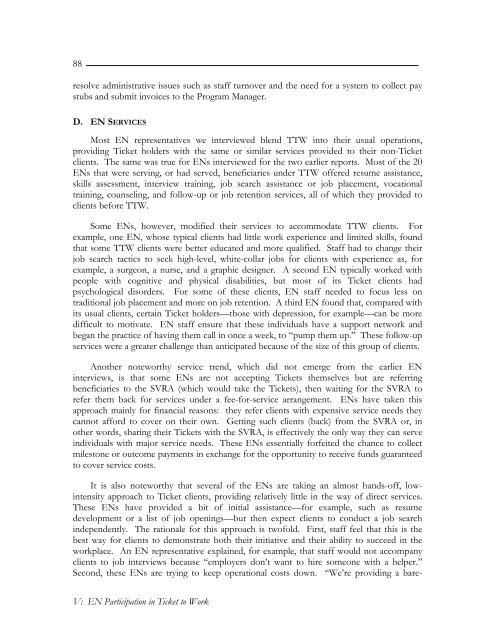Evaluation of the Ticket to Work Program, Implementation ...
Evaluation of the Ticket to Work Program, Implementation ...
Evaluation of the Ticket to Work Program, Implementation ...
Create successful ePaper yourself
Turn your PDF publications into a flip-book with our unique Google optimized e-Paper software.
88resolve administrative issues such as staff turnover and <strong>the</strong> need for a system <strong>to</strong> collect paystubs and submit invoices <strong>to</strong> <strong>the</strong> <strong>Program</strong> Manager.D. EN SERVICESMost EN representatives we interviewed blend TTW in<strong>to</strong> <strong>the</strong>ir usual operations,providing <strong>Ticket</strong> holders with <strong>the</strong> same or similar services provided <strong>to</strong> <strong>the</strong>ir non-<strong>Ticket</strong>clients. The same was true for ENs interviewed for <strong>the</strong> two earlier reports. Most <strong>of</strong> <strong>the</strong> 20ENs that were serving, or had served, beneficiaries under TTW <strong>of</strong>fered resume assistance,skills assessment, interview training, job search assistance or job placement, vocationaltraining, counseling, and follow-up or job retention services, all <strong>of</strong> which <strong>the</strong>y provided <strong>to</strong>clients before TTW.Some ENs, however, modified <strong>the</strong>ir services <strong>to</strong> accommodate TTW clients. Forexample, one EN, whose typical clients had little work experience and limited skills, foundthat some TTW clients were better educated and more qualified. Staff had <strong>to</strong> change <strong>the</strong>irjob search tactics <strong>to</strong> seek high-level, white-collar jobs for clients with experience as, forexample, a surgeon, a nurse, and a graphic designer. A second EN typically worked withpeople with cognitive and physical disabilities, but most <strong>of</strong> its <strong>Ticket</strong> clients hadpsychological disorders. For some <strong>of</strong> <strong>the</strong>se clients, EN staff needed <strong>to</strong> focus less ontraditional job placement and more on job retention. A third EN found that, compared withits usual clients, certain <strong>Ticket</strong> holders—those with depression, for example—can be moredifficult <strong>to</strong> motivate. EN staff ensure that <strong>the</strong>se individuals have a support network andbegan <strong>the</strong> practice <strong>of</strong> having <strong>the</strong>m call in once a week, <strong>to</strong> “pump <strong>the</strong>m up.” These follow-upservices were a greater challenge than anticipated because <strong>of</strong> <strong>the</strong> size <strong>of</strong> this group <strong>of</strong> clients.Ano<strong>the</strong>r noteworthy service trend, which did not emerge from <strong>the</strong> earlier ENinterviews, is that some ENs are not accepting <strong>Ticket</strong>s <strong>the</strong>mselves but are referringbeneficiaries <strong>to</strong> <strong>the</strong> SVRA (which would take <strong>the</strong> <strong>Ticket</strong>s), <strong>the</strong>n waiting for <strong>the</strong> SVRA <strong>to</strong>refer <strong>the</strong>m back for services under a fee-for-service arrangement. ENs have taken thisapproach mainly for financial reasons: <strong>the</strong>y refer clients with expensive service needs <strong>the</strong>ycannot afford <strong>to</strong> cover on <strong>the</strong>ir own. Getting such clients (back) from <strong>the</strong> SVRA or, ino<strong>the</strong>r words, sharing <strong>the</strong>ir <strong>Ticket</strong>s with <strong>the</strong> SVRA, is effectively <strong>the</strong> only way <strong>the</strong>y can serveindividuals with major service needs. These ENs essentially forfeited <strong>the</strong> chance <strong>to</strong> collectmiles<strong>to</strong>ne or outcome payments in exchange for <strong>the</strong> opportunity <strong>to</strong> receive funds guaranteed<strong>to</strong> cover service costs.It is also noteworthy that several <strong>of</strong> <strong>the</strong> ENs are taking an almost hands-<strong>of</strong>f, lowintensityapproach <strong>to</strong> <strong>Ticket</strong> clients, providing relatively little in <strong>the</strong> way <strong>of</strong> direct services.These ENs have provided a bit <strong>of</strong> initial assistance—for example, such as resumedevelopment or a list <strong>of</strong> job openings—but <strong>the</strong>n expect clients <strong>to</strong> conduct a job searchindependently. The rationale for this approach is tw<strong>of</strong>old. First, staff feel that this is <strong>the</strong>best way for clients <strong>to</strong> demonstrate both <strong>the</strong>ir initiative and <strong>the</strong>ir ability <strong>to</strong> succeed in <strong>the</strong>workplace. An EN representative explained, for example, that staff would not accompanyclients <strong>to</strong> job interviews because “employers don’t want <strong>to</strong> hire someone with a helper.”Second, <strong>the</strong>se ENs are trying <strong>to</strong> keep operational costs down. “We’re providing a bare-V: EN Participation in <strong>Ticket</strong> <strong>to</strong> <strong>Work</strong>
















